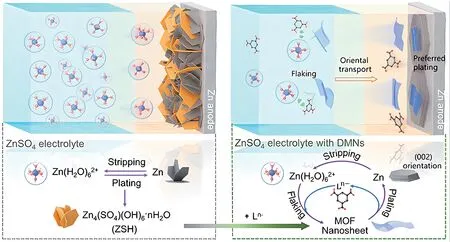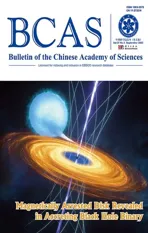Metal Organic Framework Nanosheets Employed as Ion Carriers for Self-Optimized Zinc Anode
2023-11-15ZHUKaiyue
Aqueous rechargeable zinc ion batteries are promising in electric grid storage due to their low cost and intrinsic safety.However, the practical implementation is hindered by the poor reversibility of the zinc anode, primarily caused by the chaotic Zn deposition present as dendrite and side reactions.
Recently, a research group led by Prof.YANG Weishen and Dr.ZHU Kaiyue from the Dalian Institute of Chemical Physics (DICP) of the Chinese Academy of Sciences (CAS) has proposed a strategy of “ino carriers”by importing macromolecular Zn2+carriers with a large mass-to-charge ratio to decouple the ion flux from the inhomogeneous electric field and substrate.This strategy provided an efficient pathway to overcome the dendrite and side reaction problems.
This study was published inEnergy Environmental Scienceon August 18.
The researchers found that metal organic framework(MOF) nanosheets featuring migration capability under an electric field due to their one-dimensional (1D)channel structure and preferential Zn2+adsorption,as well as unique reductive chemistry due to the weak coordination between ligands and zinc ions, enabling them to serve as dynamic Zn2+ion carriers.

By harnessing dynamic MOF nanosheets, zinc anodes underwent a remarkable self-optimization process, resulting in the creation of a highly desirable surface with an unprecedented (002) orientation that is entirely free from any undesirable byproducts (Image by ZHU Kaiyue)
The dynamic MOF nanosheets could continually optimize the zinc anode during cycling.Specifically,the zinc electrode was gradually reconstructed towards a horizontally aligned lamellae-like morphology and enhanced (002) texture, showing a relative texture coefficient of 96.9 (maximum value of 100).This optimization of the morphology and texture could be attributed to the horizontal alignment of Zn2+ions by the constraints of the MOF nanosheets.
Additionally, the presence of MOF ligands contributed to the elimination of undesirable Zn4SO4(OH)6·4H2O byproducts.These byproducts were spontaneously converted into useful MOF nanosheets through the unique properties of ligands.Consequently,Zn||Zn symmetric cells and Zn||(NH4)2V10O25·8H2O full cells employing MOF nanosheets in electrolytes exhibited outstanding cycling performance at both low and high rates.
“The versatility of the ‘ion carrier’ holds promise for potential expansion into achieving highly reversible cycling in other rechargeable metal cells, owing to its broad applicability to various ligands, substrates and electrolytes,” said Prof.YANG.
This work was supported by the National Natural Science Foundation of China and the Youth Innovation Fund of DICP.
杂志排行
Bulletin of the Chinese Academy of Sciences的其它文章
- Could Gut Bacteria Hold a Cure for Sepsis?
- Looking into the Tissue Adjacent to Tumors
- Daya Bay Collaboration Awarded 2023 High Energy and Particle Physics Prize by European Physical Society
- Largest Optical Time-domain Survey Telescope in Northern Hemisphere Goes into Operation
- CAS Paleogeneticist Awarded UNESCO Prize
- “Magnetically Arrested Disk”Revealed by Multiwavelength Observation
